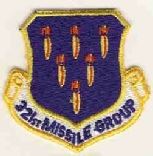321st Missile Group Grand Forks AFB, North Dakota, the sixth and final Minuteman wing (Wing VI), became fully operational in December 1966 Lineage - 321stst Bomb Group (Medium) activated 19 Jun 1942. Inactivated 12 Sep 1945. Activated in the Air Force Reserve from June 1947 to June 1949. Redesignated as 321st Bomb Wing (Medium) and inactivated October 1961. On 1 November 1963, redesignated and activated as the 321st Strategic Missile Wing (SMW). Redesignated 321st Missile Wing on 1 Sep 1991, 321st Missile Group in 1994, when the Chief of Staff of the Air Force directed that there would be only one wing on each base and other significant units would be groups, so the bomb wing at Grand Forks kept the wing title. 321st MG closed on 2 July 1998. The 321st has been designated as an Air Expendionary Group and Wing since as a provisional unit in the Middle East since closing as a missile unit. Operations Squadrons 446th Strategic Missile Squadron (SMS) activated on 1 Dec 1961, became the 446th Missile Squadron ( MS) on 1 Sep 1991. 447th SMS activated on 1 Mar 1962, became 447th MS on 1 Sep 1991. 448th SMS activated 1 May 1962, bcame 448th MS on 1 Sep 1991. The squadrons each originally had 50 Minuteman II LGM30F missiles with the Sylvania ground system, and was called Minuteman II, with the nickname “Deuce.” The 564th SMS, the 20th and final Minuteman squadron, at Malmstrom, had the same configuration as Grand Forks. This system had a completly different launch contol center (LCC)LCC configuration, much larger than the LCCs in the first five wings. Rather than use a redundant cable system to interconnect the 50 missiles in a squadron, the Sylvania system used a medium frequency radio system with large buried antennae at each LCC and LF. Between December 1971 and March 1973, the three squadrons were converted to the Minuteman III LGM-30G missiles. When the 321st MG closed, the Minuteman III missiles replaced the Minuteman II missiles in the 341st MW. One LCG, Oscar-Zero, near Cooperstown, ND, was turned over to the State of North Dakota and is now operated as the Ronald Reagan State Historic Site, along with one of the LFs. |
|



